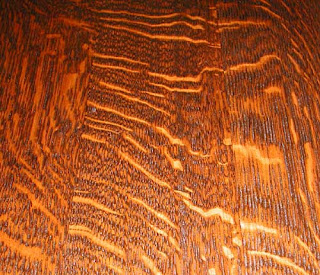 Oak first became the wood of choice during the Middle Ages when Gothic furniture was first produced, and then continued to be popular throughout the 17th century. Quarter cut oak boards known as wainscot were brought to Northern Europe as early as the 14th century. While there are so many different types of oak including Red Oak, White Oak and Live Oak, White Oak is usually used for quarter sawing. During the early 20th Century, quarter sawn oak become one of the hallmarks of the Arts & Crafts style. While other materials became incorporated into the style like mahogany and ebony, quarter sawn oak remains the wood of choice.
Oak first became the wood of choice during the Middle Ages when Gothic furniture was first produced, and then continued to be popular throughout the 17th century. Quarter cut oak boards known as wainscot were brought to Northern Europe as early as the 14th century. While there are so many different types of oak including Red Oak, White Oak and Live Oak, White Oak is usually used for quarter sawing. During the early 20th Century, quarter sawn oak become one of the hallmarks of the Arts & Crafts style. While other materials became incorporated into the style like mahogany and ebony, quarter sawn oak remains the wood of choice.Since then, quarter sawn lumber has fallen out of favor during the first half of this century because it yields less lumber per tree and takes more labor than plain sawing. With most furniture being plain sawn today, quarter sawn oak furniture have become prized period pieces and are therefore an important key to accurately recreating the true look of Arts & Crafts furniture.
 Quarter sawing means cutting at a 90-degree angle from the growth rings on a log to produce a vertical and uniform pattern grain. The grain on the face of a quarter-sawn board will be parallel lines that are straight, tight and run the length of the board. The closer the growth rings are to being 90-degrees from the face of the board, the greater the chance to getting the famous medullary ray flecks. Additional aesthetics include wavy and interlocked grains. Structural benefits to quarter sawn oak include that it reduces twisting, warping and cupping, holds finishes better, and does not allow liquids to readily pass through it.
Quarter sawing means cutting at a 90-degree angle from the growth rings on a log to produce a vertical and uniform pattern grain. The grain on the face of a quarter-sawn board will be parallel lines that are straight, tight and run the length of the board. The closer the growth rings are to being 90-degrees from the face of the board, the greater the chance to getting the famous medullary ray flecks. Additional aesthetics include wavy and interlocked grains. Structural benefits to quarter sawn oak include that it reduces twisting, warping and cupping, holds finishes better, and does not allow liquids to readily pass through it.Quarter sawn lumber is valued more than plain sawn lumber because of the greater time it takes to produce. The production of plain sawn lumber is much more efficient as it allows woodworkers to cut lumber quicker and produces less waste. Quarter sawn lumber on the other hand, takes longer. To quarter saw a log, first a log has to be cut into quarters. A board will then be cut off one face, and then the next board will be cut from the opposite face. The faces will be alternated until the quarter is completely cut.
A quarter sawn piece radiates elegance and traditional beauty. The extra work put into it is admirable and the results truly stand out. When you own a traditionally- built Arts & Crafts piece, your unit will only get better with age, making it a heirloom that will proudly remain part of your family for years.
5 comments:
What a fantastic resource, well done!
good job; i'm a realtor and now I know what quarter sawn oak is.
thanks for this; my father kept calling my parish's church pews quartersawn and I had no idea why. Indeed, they are, taking a look at your photo there! Thanks!
thanks, learned something. good article
Well written and super helpful. Thank you!!! - wendy
Post a Comment